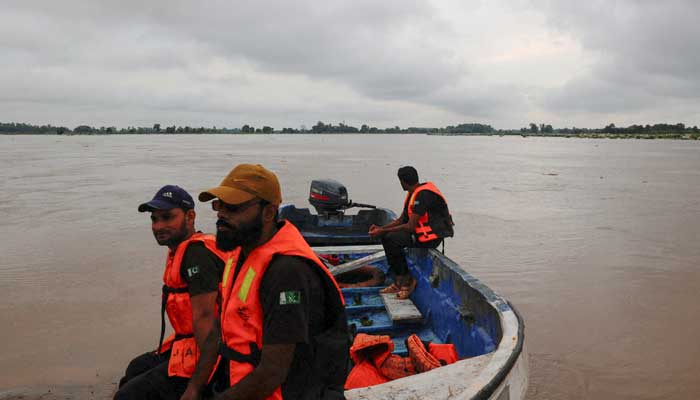Warning of High Flood in Ravi at Shahdara
Authorities have sounded the alarm over a high flood expected in the River Ravi at Shahdara tonight (Wednesday). The warning comes amid Punjab’s heightened vulnerability to flooding, following days of heavy rainfall and the release of excess water by India from its dams. According to the National Emergencies Operation Centre (NEOC), the Ravi at Jassar is carrying 202,200 cusecs, with projections suggesting a rise to nearly 229,700 cusecs. At Shahdara in Lahore, the river is currently flowing at 72,900 cusecs, putting low-lying areas such as Shahdara, Park View, and sections of Motorway-2 at risk.
Officials have cautioned that the peak flow is expected to hit Shahdara between 10pm and midnight before moving towards Balloki early Thursday morning.
India’s Release of Excess Water Raises Alarm
India has opened all gates of major dams in the Indian Illegally Occupied Jammu and Kashmir (IIOJK) region following heavy rains. Indian authorities formally warned Pakistan of the risk of downstream flooding, sharing real-time data with the Indus Water Commissioner. Based on this data, flood alerts have been issued for the Ravi at Madhopur, the Sutlej at Ferozepur, and the Chenab at Akhnoor.
The release of water has combined with Pakistan’s seasonal rains, intensifying the flood threat in Punjab and raising fears of widespread displacement.
Rivers Sutlej and Chenab Witnessing Unusually High Flows
The NEOC reported that the Sutlej is facing an extremely high flood situation. At Ganda Singh Wala, flows have been recorded at 245,000 cusecs, while Sulemanki measured 100,355 cusecs. Similarly, the Chenab has seen alarming surges, with 769,481 cusecs at Marala and 705,225 cusecs at Khanki, though flows at Khanki have since begun to ease.
The abrupt rises in both the Ravi and Chenab have caused significant concern, prompting precautionary evacuations. Thousands of residents in floodplain areas have already been shifted to safety.
Evacuations and Rescue Operations Underway
In Shakargarh, Narowal, and Gujranwala districts, emergency rescue teams have been deployed to evacuate families trapped in floodwaters. Heavy rains overnight worsened the situation, submerging schools, roads, and entire villages. In Gujranwala, sections of Head Khanki road were cut off, leaving nearby settlements isolated.
Further south, in Sindh’s Dadu district, floodwaters from the Indus River inundated villages, damaging agricultural land and destroying standing crops.
Dams Near Capacity and Flood Monitoring Efforts
The Flood Forecasting Division reported that Tarbela Dam has reached full capacity, while Mangla is nearly three-fourths filled. Although several barrages along the Indus, including Guddu and Sukkur, are experiencing low to medium floods, rivers like Jhelum and Kabul remain stable.
The National Disaster Management Authority (NDMA) is coordinating rescue and relief efforts across Punjab, operating round-the-clock through the NEOC control room. Civil and military agencies are also on high alert, ready to assist as the water levels peak.
Authorities Urge Public to Stay Away from Floodplains
Punjab Disaster Management Authority (PDMA) Director General Irfan Ali Kathia announced that water levels are expected to gradually recede following a pause in rainfall in the upper catchments. At a press briefing, he noted that although the Sutlej had experienced persistently high flooding for nearly ten days, the flow at Ganda Singh had steadied.
Kathia emphasized that the River Ravi remains a primary concern. At Jassar, flows surged above 200,000 cusecs, triggering the predicted rise at Shahdara. However, he assured that with Shahdara’s capacity of 250,000 cusecs, authorities expect to safely manage the flow, which is predicted to peak between 180,000 and 190,000 cusecs.
Army Deployed for Flood Relief Efforts
As the situation escalated, the Punjab government formally requested the deployment of army troops in six districts to bolster rescue and relief operations. Rescue 1122, civil defence, and local administration are already active, but the scale of the flooding has stretched resources thin.
The Punjab Home Department confirmed that over 167,000 people have been displaced, including nearly 40,000 who evacuated voluntarily following earlier flood warnings. Since the start of the monsoon season in late June, the nationwide death toll from flooding has climbed to 802, with half of these fatalities reported in August alone.
